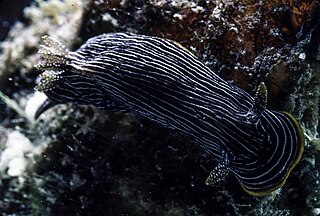
The sleepy cod is a medium-sized fish in the family Butidae, native to tropical fresh waters of northern Australia and questionably from New Guinea. It is a member of the order Perciformes, thus is unrelated to the true cods in the order Gadiformes. Neither are they closely related to the Australian freshwater cods such as the Murray cod of the genus Maccullochella.

Ellipsaria lineolata is a species of freshwater mussel, an aquatic bivalve mollusk in the family Unionidae, the river mussels. This is the sole species in the monotypic genus Ellipsaria . This species is native to the drainage systems of the Mississippi River, the Mobile River, the Tennessee River, and the Cumberland River in the United States. It exists in the midwestern United States, and has also been observed in the east coast and as far south as the Gulf of Mexico. The common name of Ellipsaria lineolata is the Butterfly Mussel.
Jacob Rudolph Hendrik Neervoort van de Poll was a Dutch entomologist who specialised in Coleoptera. He was the vice-president of Artis, the Amsterdam zoo; a member of the Netherlands Entomological Society and the Société entomologique de France. The butterfly Troides vandepolli was named, by Samuel Constantinus Snellen van Vollenhoven, curator of the Leiden Museum, in his honour.

Nembrotha lineolata is a species of nudibranch, a sea slug, a marine gastropod mollusk in the family Polyceridae. It is found in shallow water in the Indo-Pacific. It was first described in 1905 by the Danish malacologist Rudolph Bergh. The type locality is Selayar Island, Indonesia.

Chromodoris lineolata is a species of colourful sea slug, a dorid nudibranch, a marine gastropod mollusc in the family Chromodorididae.

Echinolittorina lineolata is a species of small sea snail, a marine gastropod mollusk in the family Littorinidae, the winkles or periwinkles.

Ophthalmolepis lineolata, the southern Maori wrasse, is a species of wrasse endemic to the Indian Ocean coastal waters of Australia. This species has been found at a minimum depth of 60 m (200 ft). This species grows to 40 cm (16 in) in total length. This species is the only known member of its genus.

Parmenini is a tribe of longhorn beetles of the subfamily Lamiinae.

Batocera lineolata is a species of beetle in the family Cerambycidae. It was described by Louis Alexandre Auguste Chevrolat in 1852. It is known from China, Korea, Japan and Taiwan.

Iris acutiloba subsp. lineolata is a species in the genus Iris, it is also in the subgenus of Iris. It is a subspecies of Iris acutiloba, and is a rhizomatous perennial, from the mountains of Iran, Turkey, Turkmenistan, Tajikistan and Azerbaijan. It has narrow, lanceolate, or falcate (sickle-shaped) leaves, which are grey-green and glaucous. It has a slender straight stem holding one terminal flower. The flowers, come in shades of white, cream, or creamy white and have veining that is purple or brown, or a mixture of both. It is heavily veined or streaked in purple or brown, with a dark purple-brown, spot on 3 of the outer petals and brown, dark purple, or black short beard. It is rarely cultivated as an ornamental plant in temperate regions, unless grown in a greenhouse.

Acacia lineolata, commonly known as dwarf myall, is a shrub of the genus Acacia and the subgenus Plurinerves that is endemic to an area of south western Australia.
Mesolita ephippiata is a species of beetle in the family Cerambycidae. It was described by Lea in 1918. It is known from Australia.
Mesolita interrupta is a species of beetle in the family Cerambycidae. It was described by Lea in 1918. It is known from Australia.
Mesolita myrmecophila is a species of beetle in the family Cerambycidae. It was described by Lea in 1918. It is known from Australia.
Mesolita scutellata is a species of beetle in the family Cerambycidae. It was described by Lea in 1918. It is known from Australia.
Mesolita pascoei is a species of beetle in the family Cerambycidae. It was described by van der Poll in 1892. It is known from Australia.
Mesolita simplicicollis is a species of beetle in the family Cerambycidae. It was described by Per Olof Christopher Aurivillius in 1920. It is known from Australia.
Mesolita transversa is a species of beetle in the family Cerambycidae. It was described by Francis Polkinghorne Pascoe in 1862. It is known from Australia.

Crematogaster lineolata is a species of ant in the family Formicidae.

Sepioloidea lineolata or more commonly known as the striped pyjama squid or the striped dumpling squid is a type of bottletail squid that inhabits the Indo-Pacific Oceans of Australia. Although traditionally falling within Sepiida, the cuttlefish order, it lacks a cuttlebone. More recent phylogenomic evidence suggests bottletail and bobtail squid may form their own order, Sepiolida. The striped pyjama squid lives on the seafloor and is both venomous and poisonous. When fully mature, a striped pyjama squid will only be about 7 to 8 centimetres in length. Baby striped pyjama squid can be smaller than 10 millimetres (0.39 in).











